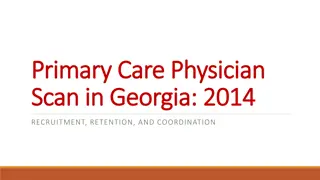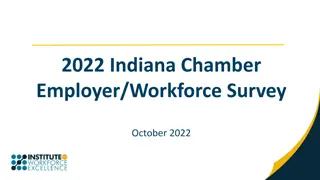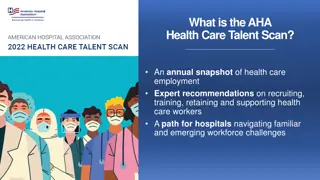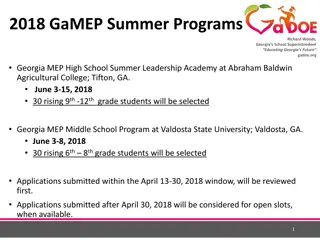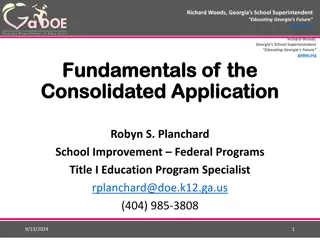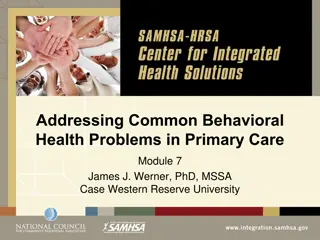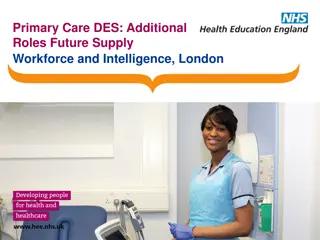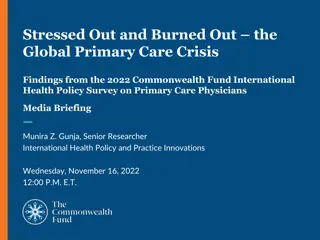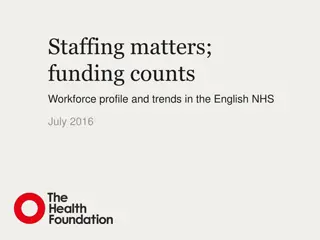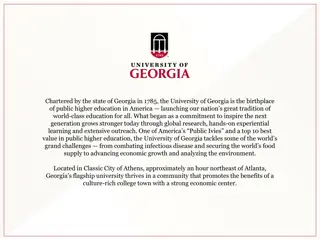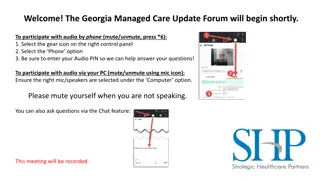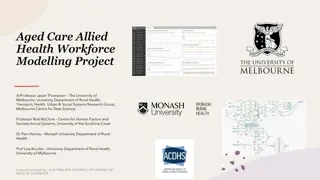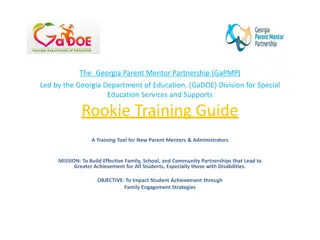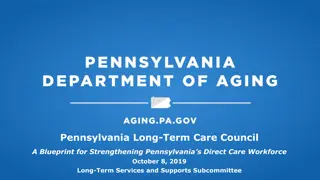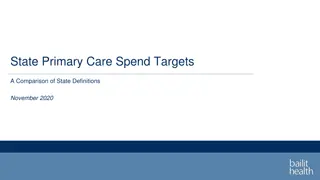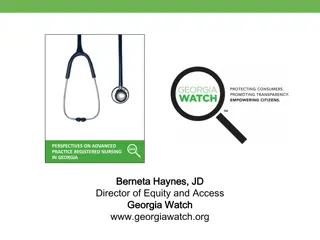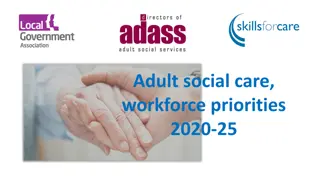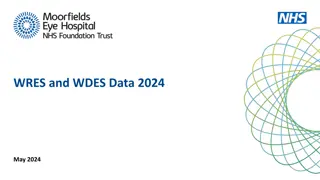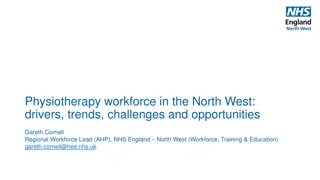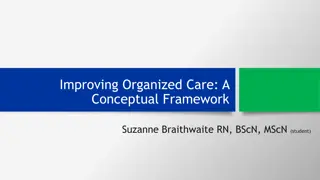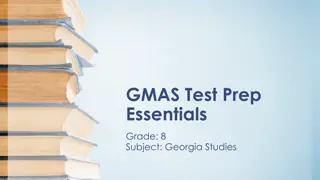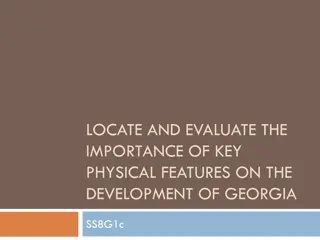Addressing Challenges in Building a Primary Care Workforce in Georgia
Discussion on the primary challenges faced in training a primary care workforce in Georgia, including projected PCP shortages, barriers to healthcare access, and the lengthy education pipeline for rural primary care providers. Solutions like placing students in rural and underserved communities for training are highlighted.
Download Presentation

Please find below an Image/Link to download the presentation.
The content on the website is provided AS IS for your information and personal use only. It may not be sold, licensed, or shared on other websites without obtaining consent from the author. Download presentation by click this link. If you encounter any issues during the download, it is possible that the publisher has removed the file from their server.
E N D
Presentation Transcript
Removing Barriers to health Removing Barriers to health care access care access: : Workforce Workforce DENISE D. KORNEGAY, MSW DENISE D. KORNEGAY, MSW EXECUTIVE DIRECTOR AND ASSOCIATE DEAN EXECUTIVE DIRECTOR AND ASSOCIATE DEAN GEORGIA STATEWIDE AREA HEALTH EDUCATION CENTERS (AHEC) GEORGIA STATEWIDE AREA HEALTH EDUCATION CENTERS (AHEC) ASSOCIATE PROFESSOR, DEPARTMENT OF FAMILY MEDICINE ASSOCIATE PROFESSOR, DEPARTMENT OF FAMILY MEDICINE MEDICAL COLLEGE OF GEORGIA @ AUGUSTA UNIVERSITY MEDICAL COLLEGE OF GEORGIA @ AUGUSTA UNIVERSITY
Financial vs. physical access Financial vs. physical access Financial access is one issue, but physical access is another. 159 Georgia Counties: 6 without a Family Physician 31 without a General Internist 63 without a Pediatrician 79 without an OB/GYN 66 without a General Surgeon
Georgia PCP projected shortage Georgia PCP projected shortage To maintain the status quo, Georgia will need an additional 2,099 primary care physicians- an increase of 38%- by 2030. 20% of this growth is projected based on increased utilization due to aging (rural populations aged 55-75 are projected to grow by 30% from 2010-2020); 66% due to population growth; and 13% due to greater insured populations following the Affordable Care Act. Petterson, Stephen M; Cai, Angela; Moore, Miranda; Bazemore, Andrew. State-level projections of primary care workforce, 2010-2030. September 2013, Robert Graham Center, Washington, D.C.
What are the primary challenges What are the primary challenges in in training, a primary care workforce in training, a primary care workforce in Georgia? Georgia?
To make a Rural Primary Care Provider The education pipeline is quite long: K-12 education (High School diploma) 4 years of undergraduate education (Baccalaureate) 2 years for a Masters (PA and APRN) 4 years of medical school (UME) 3-8 years of residency training (GME) 6 YEARS+ POST HIGH SCHOOL TO EDUCATE A NEW PA or APRN 11-16 YEARS POST HIGH SCHOOL TO EDUCATE A NEW DOC!
Placing medical, PA and APRN students into rural Placing medical, PA and APRN students into rural and underserved communities for training and underserved communities for training The more exposure a learner has to rural communities and underserved populations during his/her training, the more likely they are to practice in a rural setting. 1. Recruiting and preparing community based teaching sites Site identification Site Credentialing Rewarding volunteer community based faculty (Preceptor Tax Incentive Program- PTIP) 2. Addressing practical barriers to off campus / off site rotations. Housing issues Travel issues 3. Working with communities to develop Social Integration strategies
Solutions: Primary Care Solutions: Primary Care Student Education & Training Student Education & Training
Providing housing for students completing short term (2-8 week rotations) in communities remote from their campus Continue and increase funding the Statewide AHEC Network to provide housing for students completing community based clinical training remote from their campuses. 1. Support development, expansion, and/or maintenance of the regional campus models of education to place medical/osteopathic (and perhaps APRN and PA students) for training in more communities across the state. Support MCG s regional campus model Support PCOM s Anchor program Support Mercer s distributed campus model and CIP (PA) Support MSM s regional campus program 2.
Develop training for social integration strategies for communities hosting students and residents to provide them with tools to recruit these individuals for eventual practice. Offer technical assistance to communities to develop social integration plans. (Statewide AHEC) 3. Offering tangible rewards to community based physicians supporting medical education. Convert Preceptor Tax Incentive Program (PTIP) from a tax deduction to a tax credit. This is a priority. (Statewide AHEC) 4.
WHAT is PTIP? WHAT is PTIP? PRECEPTOR TAX INCENTIVE PROGRAM
PTIP PTIP Georgia was first in nation to create 2 other states have implemented (Colorado and Maryland) 13+ other states have legislation pending or being developed
What it does What it does It provides an economic incentive to Georgia providers to participate in the training of future health care professionals It is limited to only those providers who receive no compensation from any source to train medical, osteopathic, PA, or APRN students The incentive is only available for those students from a Georgia educational program- public or private
What is Pending? What is Pending? HB 301 which converts the existing Tax Deduction to a Tax Credit Expands eligibility to include PA and APRN preceptors Includes an incentive plan to encourage more rotations be supported Has passed House and is now in Senate Finance Committee
Rationale and Background for strategy: Rationale and Background for strategy: Georgia s primary care shortages are well documented; it is imperative that the training of medical students, physician assistant students, and advanced practice registered nurses students be secured in the state as these three disciplines form the core primary care workforce. Georgia invests heavily in the educational programs required to produce these students, and efforts such as this tax credit alleviate some of the struggles faced by these programs as they seek to secure sufficient community based training sites to educate their students.
Challenge addressed Challenge addressed Off-shore and out-of-state medical schools are using Georgia CBF and paying them +/- $1500 per rotation. Rather than enter into a bidding war with these other players, a tax credit could provide a powerful incentive to Georgia CBF to ONLY take Georgia Medical, Physician Assistant, and Advanced practice registered nurses students. If Georgia MD/DO, PA and NP programs were forced to pay $1500 / rotation, then the expected cost would be approximately $7,219,500 (4,813 rotations x $1500 each). Since the majority of these rotations occur at a program based within the University System of Georgia, the state would be asked to help fund approximately 1/3 to 1/2 of these funds; without additional funding, students matriculating in these programs would be asked to pay additional fees. Additionally, given the deep pockets of the off-shore and out of state programs, the price for rotation could and most likely would be pushed higher as the bidding war begins for the community- based clinical training sites and faculty.
How many student How many student rotations are needed? rotations are needed?
Medical / Osteopathic Students Medical / Osteopathic Students Each medical / osteopathic student has approximately 7 required core clerkship rotations in their third year and approximately the same in the 4th year. Each rotation lasts 4-6 weeks on average. Approximately 40% of these required clerkship rotations occur in community based settings with non-compensated volunteer faculty; In 2016, there were approximately 594 3rd year Georgia Medical / Osteopathic Students at our five schools; 594 x 7 required core clerkships = 4,158 rotations; 4,158 x 40% in community settings = 1,663 rotations eligible for tax credit.
Physician Assistant Students Physician Assistant Students Each PA student completes approximately 50% of their required clinical rotations in off-campus community based training sites with practicing physicians and/or licensed PAs. The same seven clerkships are required as for medical students. There are approximately 300 Georgia Physician Assistant students at five institutions; Each rotation lasts 4-6 weeks on average; 300 students x 7 rotations= 2,100 rotations; 2,100 rotations x 50% in community based training sites= 1,050 rotations eligible for tax credits.
APRN Students APRN Students There are 15 Advanced Practice Registered Nurse Masters Programs in Georgia with a total approximate enrollment of +/- 700. Nursing curriculum differs from the other two disciplines, but approximately each student would need 2 or 3 supported rotations. 700 X 3 = 2,100 rotations eligible for tax credits
Who benefits? Who benefits? Eligibility: Any non-compensated community based physician, advanced practice registered nurse, or physician assistant, licensed in the state of Georgia, providing preceptorship training for a medical / osteopathic student (MD/DO) OR a Georgia Physician Assistant (PA) student OR an Advanced Practice Registered Nurse (APRN) student matriculating at a public or private Georgia educational institution ; CBF must provide a minimum of three rotations to be eligible for the tax credit (credits are awarded retroactively to include these). The educational institution must certify these rotations as complete through reporting to the Georgia Statewide Area Health Education Centers (AHEC) Program Office at Augusta University.
What do they receive? Incentive structure: To encourage community based faculty to participate at the highest level, the amount of tax credits increase with service. For medical/osteopathic preceptors, the first 3 rotations will be provided credits worth $500 each; subsequent credits will be awarded credits at $1000 each for rotations number 4-10. For advanced practice nursing and physician assistant preceptors, tax credits of $375 will be provided for rotations 1-3; credits will increase to $750 per rotation for rotations 4-10. These differences reflect income earning differences among the professions. No preceptor will receive credits for more than 10 certified rotations. (A rotation is defined as 160 hours of community based teaching.)
Other considerations Other considerations Boundaries Recommended Tax Credit Caps will have to be identified so there is no incentive to take more students than quality education standards can sustain (e.g. maximum of $10,000 credit annually). Tax credit would be non-transferable. Unused Tax credit would not carry over to another tax year. There should not be a cash-out option for unused credit.
2017 Fiscal Note 2017 Fiscal Note
The Statewide AHEC Network is ready to assist. Please contact me with any requests. Denise D. Kornegay, MSW Executive Director and Associate Dean Georgia Statewide Area Health Education Centers (AHEC) dkornega@augusta.edu 706-721-8557


